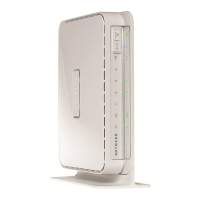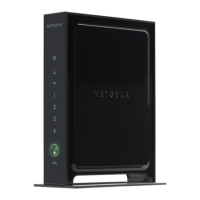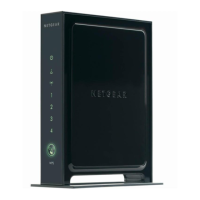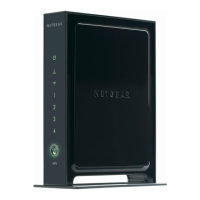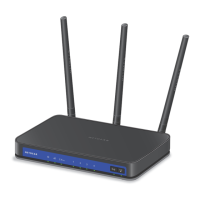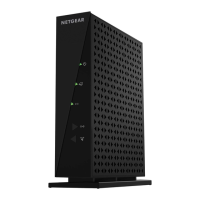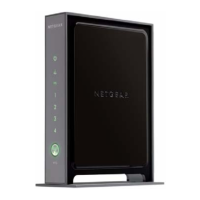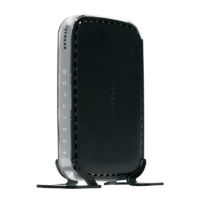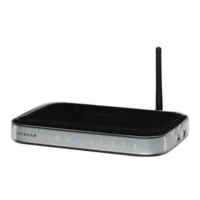Do you have a question about the NETGEAR WNR2200 and is the answer not in the manual?
Describes the physical components and status lights of the router.
Details the status lights and switch buttons on the router's front panel.
Details the ports and physical connectors found on the router's rear panel.
Explains the information found on the label at the bottom of the wireless router.
Provides guidelines for optimal placement of the wireless router for best performance.
Guides through the process of installing the wireless router.
Walks through router setup steps, including internet and wireless configuration.
Provides instructions for manual router installation for advanced users or specific OS.
Details the physical connection steps for the router to the modem and computer.
Guides on logging into the router and configuring internet access settings.
Explains how to check for and install new router firmware for improved features.
Provides steps to access the router's web-based management interface.
Guides on using the setup wizard to configure the internet connection.
Details how to view or manually set up ISP connection parameters.
Discusses factors for compliance, compatibility, and optimal wireless network configuration.
Provides recommendations for router placement to maximize network speed and range.
Explains different wireless security protocols like WEP, WPA, and WPA2 for network protection.
Guides on how to manually set up wireless network name (SSID) and security.
Details the steps to set up WEP data encryption for wireless security.
Explains how to configure strong wireless security using WPA and WPA2.
Describes using WPS for easy and secure wireless network setup.
Provides steps for adding wireless clients using the WPS button method.
Details how to add wireless clients using the WPS PIN entry method.
Explains how to configure advanced settings related to WPS functionality.
Guides on adding more wireless clients to the network after initial WPS setup.
Steps to connect both WPS-enabled and non-WPS capable devices to the network.
Explains how to enable or disable the wireless router functionality.
Guides on setting up a separate guest network for visitors.
Guides on changing the router's administrator password for enhanced security.
Explains how to update the router's software for improved performance and features.
Explains how to save and retrieve router configuration settings.
Guides on configuring LAN IP settings, DHCP server, and address reservation.
Guides on configuring WAN settings like DMZ server and port scan protection.
Explains how to reset the router to factory defaults and restore the default password.
Describes the physical components and status lights of the router.
Details the status lights and switch buttons on the router's front panel.
Details the ports and physical connectors found on the router's rear panel.
Explains the information found on the label at the bottom of the wireless router.
Provides guidelines for optimal placement of the wireless router for best performance.
Guides through the process of installing the wireless router.
Walks through router setup steps, including internet and wireless configuration.
Provides instructions for manual router installation for advanced users or specific OS.
Details the physical connection steps for the router to the modem and computer.
Guides on logging into the router and configuring internet access settings.
Explains how to check for and install new router firmware for improved features.
Provides steps to access the router's web-based management interface.
Guides on using the setup wizard to configure the internet connection.
Details how to view or manually set up ISP connection parameters.
Discusses factors for compliance, compatibility, and optimal wireless network configuration.
Provides recommendations for router placement to maximize network speed and range.
Explains different wireless security protocols like WEP, WPA, and WPA2 for network protection.
Guides on how to manually set up wireless network name (SSID) and security.
Details the steps to set up WEP data encryption for wireless security.
Explains how to configure strong wireless security using WPA and WPA2.
Describes using WPS for easy and secure wireless network setup.
Provides steps for adding wireless clients using the WPS button method.
Details how to add wireless clients using the WPS PIN entry method.
Explains how to configure advanced settings related to WPS functionality.
Guides on adding more wireless clients to the network after initial WPS setup.
Steps to connect both WPS-enabled and non-WPS capable devices to the network.
Explains how to enable or disable the wireless router functionality.
Guides on setting up a separate guest network for visitors.
Guides on changing the router's administrator password for enhanced security.
Explains how to update the router's software for improved performance and features.
Explains how to save and retrieve router configuration settings.
Guides on configuring LAN IP settings, DHCP server, and address reservation.
Guides on configuring WAN settings like DMZ server and port scan protection.
Explains how to reset the router to factory defaults and restore the default password.
| Ethernet LAN | Yes |
|---|---|
| Networking standards | IEEE 802.11b, IEEE 802.11g, IEEE 802.11n |
| Ethernet LAN data rates | 10, 100 Mbit/s |
| Ethernet LAN interface type | Fast Ethernet |
| DHCP client | No |
| Security algorithms | 128-bit WEP, WPA, WPA-PSK, WPA2-PSK |
| Ethernet LAN (RJ-45) ports | 5 |
| Bandwidth | 2.4 GHz |
| Weight (imperial) | 0.72 lbs |
| Dimensions (WxDxH) | 130 x 35 x 175 mm |
| USB ports quantity | 1 |
| Networking features | Ethernet, Fast Ethernet |
| Compatible operating systems | Windows 7, Vista, XP, 2000 - Mac OS - UNIX - Linux |
| Dimensions (W x D x H) (imperial) | 5.12 x 1.38 x 6.89 \ |
| Certification | RoHS |
| Product color | White |
| Depth | 35 mm |
|---|---|
| Width | 130 mm |
| Height | 175 mm |
| Weight | 0.33 g |
